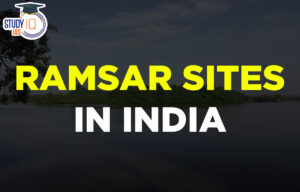StudyIQ is India’s Best Website for UPSC, State PSC, and Judiciary exam preparation. We offer a wide array of resources designed to help aspirants succeed in these highly competitive exams. Our platform provides UPSC Online Coaching, Daily Current Affairs, Government Schemes Updates, General Knowledge Updates, and State PSC Updates, ensuring that you stay well-informed and prepared at all times.
We cover a diverse range of subjects, including History Updates, Geography Updates, Indian Polity Updates, Environment Updates, Science Tech Updates, Economy Updates, and Art and Culture Updates. Our Biography Updates help you learn about influential figures that are often tested in various exams.
Trending Posts
- Reforms Needed in India’s Political Funding SystemDecember 31, 2025Political funding plays a decisive role in shaping electoral outcomes and democratic governance in India. However, repeated ...
- Happy New Year 2026: StudyIQ Family’s Special Message to UPSC and State PCS AspirantsDecember 31, 2025As we welcome the New Year 2026, it’s a moment of fresh beginnings, renewed determination, and focused ...
- Chronic Obstructive Pulmonary Disease (COPD): Causes, Symptoms, Risk Factors, Treatment and PreventionDecember 31, 2025Chronic Obstructive Pulmonary Disease (COPD) is a serious, progressive lung disorder that restricts airflow and makes breathing ...
- Ancient Buddhist Site Discovered in Kashmir: Zehanpora Excavation and Buddhist HeritageDecember 31, 2025A major archaeological discovery at Zehanpora village in Baramulla district, Jammu and Kashmir, has brought Kashmir’s long-neglected ...
- UPSC CDS 1 Final Result 2025 Declared: Download PDF and Check OTA Merit ListDecember 30, 2025The UPSC CDS 1 Final Result 2025 has been officially declared, bringing an end to months of ...
- Ramsar Sites in India 2025 List: Names, Check State-wise List with MapDecember 30, 2025India’s wetland conservation story has accelerated in recent years, and Ramsar Sites have become one of the ...
- SEBI’s SWAGAT-FI Framework for Low-Risk Foreign Investors: Meaning, Objectives, Benefits and ImpactDecember 30, 2025In a significant move to enhance India’s attractiveness as a global investment destination, the Securities and Exchange ...
- How the US and China Are Sabotaging the Global EconomyDecember 30, 2025The global economy is increasingly becoming a casualty of the strategic rivalry between the United States and ...
- Village Defence Guards (VDGs): Role, Structure, Training, Challenges and SignificanceDecember 30, 2025Village Defence Guards (VDGs) are community-based security volunteers in Jammu and Kashmir, created to strengthen grassroots defence ...
- Rakhigarhi Mahotsav Turns Harappan Site into a Living ClassroomDecember 30, 2025The Rakhigarhi Mahotsav, organised from 26 to 28 December 2025 by the Haryana Directorate of Archaeology & ...
Government Schemes
- Mukhyamantri Majhi Ladki Bahin Yojana, Objective, Eligibility Criteria and Benefits
- PM MITRA Parks, Objectives, Key Features and Government Schemes
- Rashtriya Gokul Mission (RGM), Objectives and Key Initiatives
- Unified Pension Scheme (UPS), Key Features and Significance
- PM Vishwakarma Scheme, Features, Eligibility and Benefits
- Fast Track Immigration: Trusted Travellers Programme (FTI-TTP)
History
- Birsa Munda Birth Anniversary 2025: Life Story, Ulgulan Movement and Key Achievements
- Military Innovations of Afghans and Turks (10th–18th Century)
- Self-Respect Movement, History, Objective and Significance
- Partition Horrors Remembrance Day, History and Significance
- List of Freedom Fighters of India (1857-1947) and their Contribution
- August Offer, Background, Proposal, Response and Evaluation
Geography
- Future Ready Disaster Management in Himalayas
- Places in News for UPSC 2026 for Prelims and Mains Exam
- Lake Natron: Location, Features, Wildlife and Ecological Significance
- Erra Matti Dibbalu Added to UNESCO Tentative List
- Offshore Aquifers: Formation, Distribution and Significance
- Vembanad Lake, Location, Importance and Threats
Indian Polity
- SLAPP Suits: Meaning, Examples, Impact on Free Speech and Democracy
- Finance Commission of India, Articles and Constitutional Provisions
- High Number of Pending Cases in Supreme Court of India
- NITI Aayog: Objectives, Functions, Structure and Major Initiatives
- Parliament of World’s Religions, Aim, Participants and Legacy
- Commonwealth Parliamentary Association (CPA), Objectives and Key Activities
Environment
- Ramsar Sites in India 2025 List: Names, Check State-wise List with Map
- List of National Parks in India 2025, Check State-wise List
- Bonnet Macaques: Habitat, Features, Behaviour, and Conservation Status
- Periyar Tiger Reserve, Map, Flora, Fauna and Significance
- Project Cheetah in India, Objectives, Challenges and Criticisms
- UNESCO’s Tentative List of World Heritage Sites
Economy
- SEBI’s SWAGAT-FI Framework for Low-Risk Foreign Investors: Meaning, Objectives, Benefits and Impact
- Out-of-Pocket Health Expenditure, Reasons, Consequences and Government Initiatives
- Treasury Bills (T-bills): RBI Cuts Holdings in US Treasury Securities
- Fisheries Sector in India, Current Status and Challenges
- Next Gen GST Reforms: FM Nirmala Sitharaman Announced New GST Rates List 2025
- State of Economy Report 2025, Purpose and Key Highlights
Biography
- Birsa Munda Birth Anniversary 2025: Life Story, Ulgulan Movement and Key Achievements
- Jawahar Lal Nehru Biography: Celebrating His 137th Birth Anniversary in 2026
- Lal Bahadur Shastri Jayanti 2025: Remembering India’s Second Prime Minister
- Mahatma Gandhi Biography: 156th Birth Anniversary of Mahatma Gandhi
- Bhagat Singh Jayanti 2025: Biography, History, Revolutionary Activities
- Narendra Modi Biography, Age, Education and Political Career
Best UPSC IAS Preparation Website 2025
The objective of the StudyIQ is to provide every student across the country with affordable resources that can help them in their preparation for UPSC, State PSC and Judiciary exams.
StudyIQ covers all the recruitment information from the start till the end. After the release of the notification of the exam, we cover the detailed information that a candidate wants to know about a particular recruitment, such as the notification, important exam dates, vacancy details, eligibility criteria, exam pattern, syllabus, and educational qualifications. We also provide you with a direct link to download the notification PDF directly and steps to download or apply for the particular examination from the respective official website.
StudyIQ provided appropriate study material with the test series, book kit, mock test, previous years’ question papers with solutions, cut off, and daily MCQs. We provide you with vast knowledge of all subjects required for examination, section-wise knowledge, and also videos on the daily relevant current affairs topics on our StudyIQ YouTube platform.
Our test series, daily study notes/PDF, and mock tests help candidates prepare themselves on a daily basis for the UPSC, State PSC, and Judiciary examinations. This will help candidates increase their speed and Accuracy without going to any of the big cities for preparation.
Candidates can attempt proper section-wise mock tests for all topics at their home comfort zone. We also provide daily MCQs for a particular topic of the subject.
As we see there are ample amounts of study materials available in the market that sometimes dilute the focus of the candidates from the focused area. So, the StudyIQ team provides you with all relevant information in one place in a systematic way that can help you figure out the strategy and planning to complete their syllabus in a timely manner.
Best Website for UPSC Preparation 2025
The Union Public Service Commission conducts the UPSC CSE exam every year for the recruitment of various vacancies for the various posts of Group A and Group B under the central government. UPSC Civil Service 2025 is the biggest and most prestigious government examination. StudyIQ provides you with detailed information regarding the notification, exam pattern, eligibility criteria, important dates and syllabus, and Results.
Best UPSC Civil Service Preparation Website FAQs
Q. How do I start my UPSC preparation?
Ans. Candidates can start their UPSC preparation from the StudyIQ platform in a systematic way where you can find Daily Current Affairs, Burning Issues, Hindu Analysis, PIB Analysis and many more.
Q. How to cover current affairs when the IAS preparation syllabus is so vast?
Ans. Current Affairs for the IAS preparation is a very important part for which you can refer the StudyIQ’s Daily Current Affairs news Analysis and monthly magazine.
Q. Is self-preparation for the IAS exam enough to clear it?
Ans. Self-preparation for the IAS exam is a good choice but you need to start preparation in an organized manner with relevant study materials and proper strategy for which the StudyIQ platform can play an important role to provide all the UPSC-related materials and guidance at a place.
Q. Where to download UPSC study materials/IAS study material PDF?
Ans. Candidates can easily download UPSC study materials/IAS study material PDFs from India’s best UPSC platform StudyIQ.
Q. What are the Study Materials for GS preparation for IAS?
Ans. The Study Materials for GS preparation for the IAS exam include mainly NCERT from classes 6th to 12th, Daily Current Affairs & News analysis integrate with the static part and also refer to StudyIQ’s reference books such as Indian Geography, Indian Polity, Indian Economy, Indian Art & Culture and Fundamentals of Geography.
Q. Which website is best for the UPSC IAS exam preparation?
Ans. StudyIQ is the best platform for every aspect of the UPSC IAS exam preparation from scratch.




































